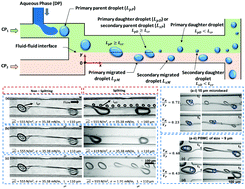Continuous splitting of aqueous droplets at the interface of co-flowing immiscible oil streams in a microchannel†
Abstract
We report the continuous splitting of aqueous droplets at the interface between two co-flowing immiscible oil streams in a microchannel. The aqueous droplets initially present in a primary continuous stream (CP1) migrate into a secondary continuous stream (CP2) when the ratio of the non-inertial lift force to the interfacial tension force exceeds a critical value (K. S. Jayaprakash, U. Banerjee and A. K. Sen, Langmuir, 2016, 32, 2136–2143). Here, experiments were performed to understand the droplet splitting phenomenon and demonstrate the splitting of droplets encapsulating microbeads and cells. The results showed that the droplet splitting phenomenon is governed by the capillary number Ca, which is a function of the average shear stress  across the channel, interfacial tension σ between the CP1 and the droplet phase and the droplet length-scale L. Irrespective of the individual values of these parameters, droplet splitting was observed when the capillary number Ca exceeds a critical value Cacr, which was found to be a function of droplet to CP2 viscosity ratio λ. The Cacr was found to be minimum for λ ≈ 1 but higher for droplets of λ ≫ 1 and λ ≪ 1. The sizes of the primary and secondary daughter and migrated droplets (i.e. Lp|sD and Lp|sM) were found to increase linearly with the increase in the size of the primary or secondary parent droplets (Lp|sP). Splitting of parent droplets encapsulating a single microbead or PBMC showed that after splitting, the presence of the microbead or PBMC in the daughter or migrated droplets depends on the ratio of the size of the migrated droplets to that of the parent droplet (i.e. VM/VP). Finally, splitting of parent droplets containing two or more microbeads or cells into droplets containing a single particle or cell was demonstrated. A new paradigm of droplet splitting is reported that could find applications in soft matter and single-cell studies.
across the channel, interfacial tension σ between the CP1 and the droplet phase and the droplet length-scale L. Irrespective of the individual values of these parameters, droplet splitting was observed when the capillary number Ca exceeds a critical value Cacr, which was found to be a function of droplet to CP2 viscosity ratio λ. The Cacr was found to be minimum for λ ≈ 1 but higher for droplets of λ ≫ 1 and λ ≪ 1. The sizes of the primary and secondary daughter and migrated droplets (i.e. Lp|sD and Lp|sM) were found to increase linearly with the increase in the size of the primary or secondary parent droplets (Lp|sP). Splitting of parent droplets encapsulating a single microbead or PBMC showed that after splitting, the presence of the microbead or PBMC in the daughter or migrated droplets depends on the ratio of the size of the migrated droplets to that of the parent droplet (i.e. VM/VP). Finally, splitting of parent droplets containing two or more microbeads or cells into droplets containing a single particle or cell was demonstrated. A new paradigm of droplet splitting is reported that could find applications in soft matter and single-cell studies.



 Please wait while we load your content...
Please wait while we load your content...